
13 minute read
Garden Observations - 2004
by Richard Stewart
It was highly unlikdy that the aceptionally good sightings in 2003 would be repeated but neverthdess our garden in Westerfield Road, Ipswich, has again had some interesting sightings. For the second year we had just one visit from a Purple Hairstreak, on July 8th and this has set me thinking about where it would have come from.
A large Oak is close to our house but many observations have failed to spot the species there though there may be Oaks with this buttetfly along the nearby Spinney linking Westerfield and Tuddenham Road, not at present available for me to explore. I doubt if any research has been carried out about Purple Hairstreak dispersal distances so I have decided to use an old school compass and draw a circle, with a diameter of three quarters of a mile, from our house and try to explore every Oak at a suitable time. Already I have discovered six new Oaks with the buttetfly present, one only about four hundred yards from our house. It will probably take another year or two to do it thoroughly but I confidently anticipate many more host trees being found.
The large Swallowrail, which flew quickly past me at the bottom of our garden on August 3rd was an incredible surprise, and it disappeared over • the back fence before Marie could see it and didn't return. This brings my garden total of species up to 26 but there is, with this butterfly, always the possibility of breeding and releasing, as almost cenainly occuned on the Rivers Estate in 1998. However, there were two other sightings of what was probably the same bunerfly, in Ipswich, from Iris Maeers in Holywells Park and Pat Gondris at St. Edmund's Road; also, this was a time when more migrants were coming in and just three days later I was observing Clouded Yellows at Piper's Vale on the edge of Ipswich. Finally, even though we keep a close eye on our garden wildlife, we probably missed a large influx of the migrant Silver Y moth. Marie spotted one on Valerian outside our French window and a closer examination revealed at least fifty, nectaring also on two varieties of Buddleia, Verbena and Jasmine. We have never seen anything like this number before in the garden and a count the next night gave a total of twenty-three. This was on August 11 th and 12th during the time already mentioned when • other migrants were coming in, but it did occur to us that the moths were feeding mainly on our large Buddleia, which was past its peak of flowering. We were left wondering whether the number would have been greater, had we looked late in the day during the earlier part of August.
Peacock
by Douglas Hammersley
Silver Y Moth
by Mervyn Crauford
Birds of a different colour
By James Mann
When we came to live in the deep south of France we were well aware that Swallowtails, Painted ladies, aouded Yellows and many of the lesser seen British Blues would be classed as common and that many of our Tortoiseshdls would be large and our Whites Black-ffllled. We had given little thought to the birds, neither of us being aperts in ornithology. What we first noticed was how many things were the same.
In Darsham, Anne had fed a small flock of Collared Doves and felt she would miss them but within days she had another eager group in the garden here asking to be fed or were they the same ones that had followed us down? Angry Blackbirds shouting at the cats told us that we had a pair nesting in the ivy over-growing the garage. Cheeky Sparrows were soon sharing food with the Doves. We also found that we had a resident Robin. One evening at dusk we were sitting outside a cafe in the centre of the town enjoying a cool beer when the peace was disturbed by a cacophony of bird cries coming from the plane trees. As we watched wave upon wave of anything up to a hundred Starlings swooped in from the surrounding countryside to roost for the night. From the numbers we counted there were many thousands, where they all go during the day we have no idea. It was fortunate that afrer twenty min1,1tes or so of argument they settled down quietly to sleep for this is a daily event. Early one spring morning Anne heard a strange·bird call, we quickly tracked it down to a male Hoopoe sitting on our T.V. aerial Hoo Hoo pooing for a mate. Our bird book tells us he does this out of sight in the crown of a tree but this one persisted with our T.V. aerial for several weeks before he left. We never saw a female at the house but hoped that he had success and was the male of one of the several pairs we frequently saw near the river on our evening walks. The trees that he should have been calling from give home to several rarely seen but regularly heard Nightingales.
In the summer we have crowds of Swifts screaming round the houses cutting down the insect population. They leave us in the autumn but the more sedate Swallows and Martins although diminished in numbers are often seen flying in small groups over the river all through the winter.
The plain where our vast areas of vines are grown does not attract a great many birds but in the wetter areas towards the river both the Llttle and Cattle Egret can be seen together with their larger cousin the Grey Heron. In late summer the trees and any likely structures in the town are invaded by the western population of migrating White Storks having a few days rest before crossing over into Spain to make for Gibraltar. They are not at all shy and are happy to pose, albeit high up, to be photographed from all angles. last September Anne took a wrong turning when going to collect some chairs she had bought the previous day at Canet en Roussillon Vide Grenier and found herself on the narrow strip of land between the sea and the salt water Etang de Canet which is very shallow, she had to stop to find out why it had turned pink. She discovered that the whole etang was massed with Pink Flamingos having a top up meal before moving further south for the winter. When I went to see them later in the week our small resident group were scill there but the huge mass had flown away. When taking part in English Butterfly walks I have often heard the word "raptor" spoken in awe so decided ro have a look for them here. If one decides to be lazy it is possible to visit Chateau Valmy where trained Owls, Hawks, Eagles and Vultures fly low over the heads of the spectators but I decided that that was cheating. Along and above the main road verges we often see Kestrels and the rare Sparrowhawk and often on the top of electricity poles we see stationary Buzzards waiting
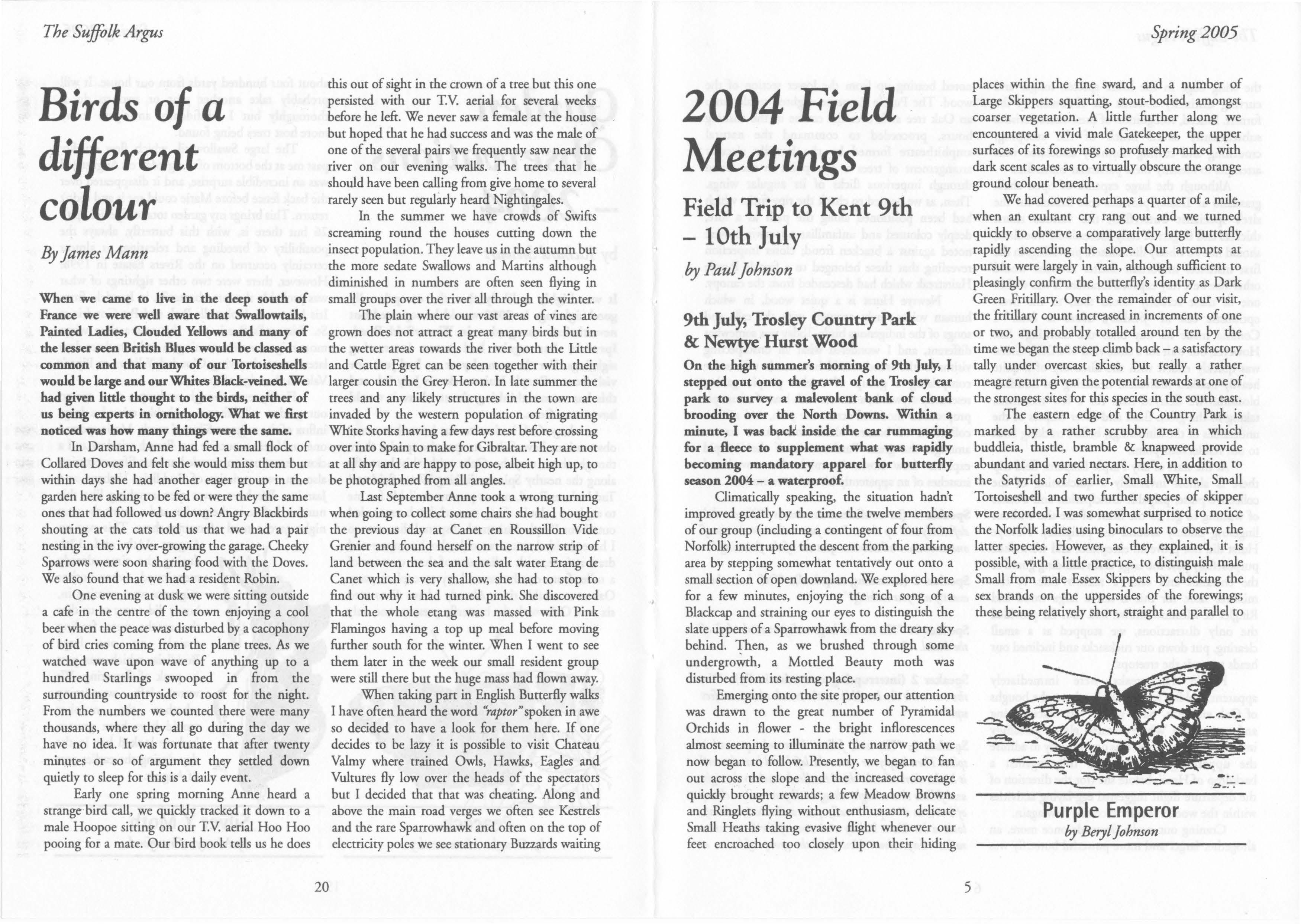
for a tasty meal to come into sight. In the spring up in the mountains 20 or more of these Buzzards are often sighted slowly drifting north at high altitude. The height makes their speed deceptive, this April I watched a dozen slowly appear over a ridge, within five minutes they were lost from sight several kilometres away. Even now afrer several sightings I find it very exiting when one of our randonners shouts "Eag!.e" and there high in the sky are one or two beautiful Golden Eagles. It is amazing how they soar around in the air currents needing only a tilt of the wings or a twist of the wingtip feathers to change direction. Only when they decide to take their searching pattern to another area do they give a couple of strong wing strokes and in seconds disappear over a ridge. During one of the early randonnes near the Pie de Costabonne we sighted five large birds flying high above us, I, now thinking I was an expert said Eagles, the real man of knowledge corrected me and said that if there were
Clouded Yellow
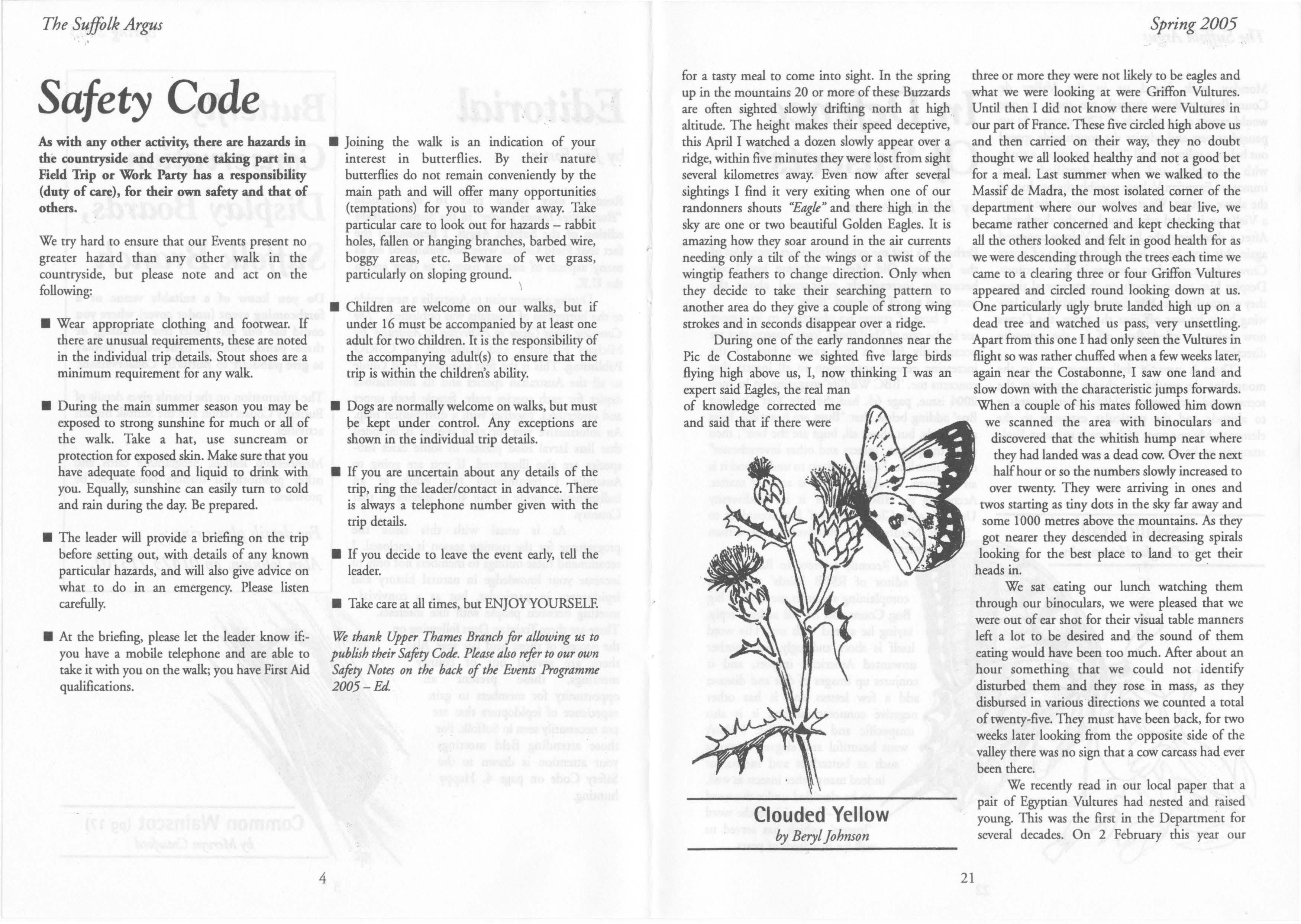
by Beryl Johnson
three or more they were not likdy to be eagles and what we were looking at were Griffon Vultures. Until then I did not know there were Vultures in out part of France. These five circled high above us and then carried on their way, they no doubt thought we all looked healthy and not a good bet for a meal. Last summer when we walked to the Massif de Madra, the most isolated comer of the department where our wolves and bear live, we became rather concerned and kept checking that all the others looked and felt in good health for as we were descending through the trees each time we came to a clearing three or fout Griffon Vultures appeared and circled round looking down at us. One particularly ugly brute landed high up on a dead tree and watched us pass, very unsettling. Apart from this one I had only seen the Vultures in flight so was rather chuffed when a few weeks later, again near the Costabonne, I saw one land and slow down with the characteristic jumps forwards. When a couple of his mates followed him down we scanned the area with binoculars and discovered that the whitish hump near where they had landed was a dead cow. Over the next half hour or so the numbers slowly increased to over twenty. They were arriving in ones and twos starting as tiny dots in the sky far away and some 1000 metres above the mountains. As they got nearer they descended in decreasing spirals looking for the best place to land to get their heads in. • We sat eating our lunch watching them through our binoculars, we were pleased that we were out of ear shot for their visual table manners left a lot to be desired and the sound of them eating would have been too much. After about an hour something that we could not identify disturbed them and they rose in mass, as they disbursed in various directions we counted a total of twenty-five. They must have been back, for two weeks later looking from the opposite side of the valley there was no sign that a cow carcass had ever been there. We recently read in our local paper that a pair of Egyptian Vultures had nested and raised young. This was the first in the Department for several decades. On 2 February this year our
Monday walk found us in the Valley de Coumellade walking through the snow, as one would expect at an altitude of 1700 metres. As we paused to rest and admire the countryside spread out below a solitary small "Eagk" appeared, a study with binoculars and it was identified as an immature Egyptian Vulture possibly the product of the above mating. We stopped to eat at the Cabin a Vielle an isolated refuge used by the shepherds. After a short time the Egyptian Vulture appeared again this time being harassed by a pair of angry Crows who resented its presence in their territory. Despite him turning back on them several times they eventually wore him down and with a few lazy wing beats he was off over the ridge, the Crows now being satisfied flew off in the opposite direction.
There is never a dull moment up in the mountains, the weather can change in minutes, the scenery and variation of wildlife differs according to altitude and the particular exposure to the elements. My one great wish now is to see an Eagle stooping on its prey.
In Defence Of 'Insects'
by Richard Stewart
Perhaps it's just me exhibiting more examples of the 'grumpy Old Men' syndrome but I am becoming increasingly concerned about the increased use of the word 'Bugs'.
I have of course no objection to its proper use in the case of Shieldbugs, lovely insects that we occasionally find in our garden, but it's the increasing general application to all insects that concerns me. 'BBC Wildlife' magazine, in its June 2004 issue, page 64, had the title 'Get The Bug Bug' adding below that "Bugs are beautiful, bugs are beastly, but above all, bugs are the best", then using the phrase "insects and other invertebrates" on the next line. I am also given to understand it is an acronym, though for what is another matter. According to 'BBC Wildlife' it is 'Biodiversity Underpinning Global Survival' but according to Swallowtail ~=E_nglish Nature it is 'Biodiversity In Urban _____ b_7_D_ou_~_1as __ H._a_m_m_ers_ley __ /._~_,_lllll,,iik?fW7· ',iji Gard:::!:ce;;y J;;t~i:~t:a::n::
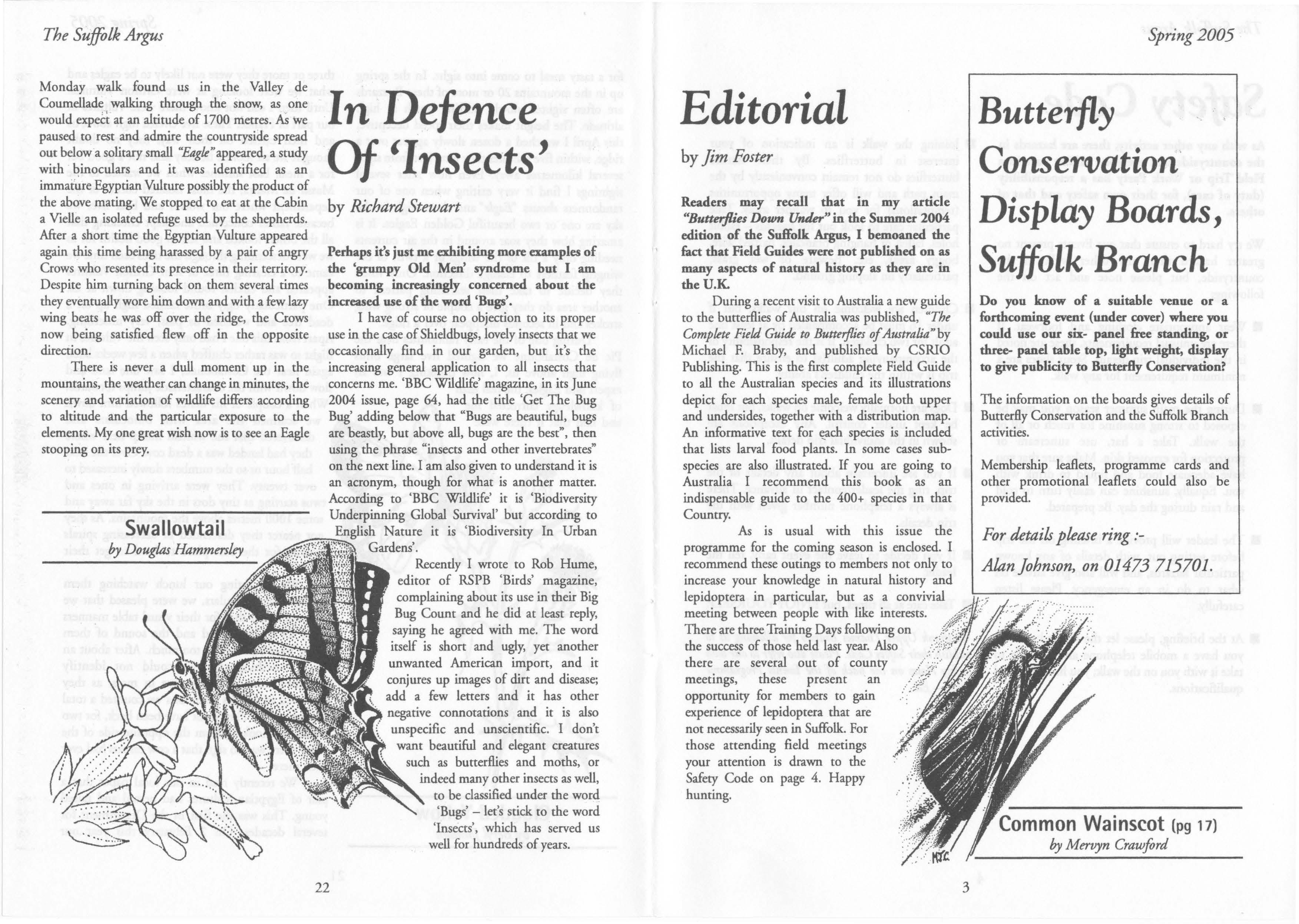
complaining about its use in their Big
Bug Count and he did at least reply, saying he agreed with me. The word itself is short and ugly, yet another unwanted American import, and it conjures up images of dirt and disease; add a few letters and it has other negative connotations and it is also ' unspecific and unscientific. I don't want beautiful and elegant creatures such as butterflies and moths, or indeed many other insects as well, to be classified under the word 'Bugs' - let's stick to the word 'Insects', which has served us well for hundreds of years.
Editorial
Copy Dates
Contributions for our newsletter should reach the Editor (address on back page) no later than:
Spring Christmas Eve
Summer April Fools Day
Autumn August Bank Holiday
Any piece of writing that is considered to be of interest will be published together with line drawings/prints /photographs. The Suffolk Argus is your magazine, so please let us hear from you.
To advertise in the Suffolk Argus
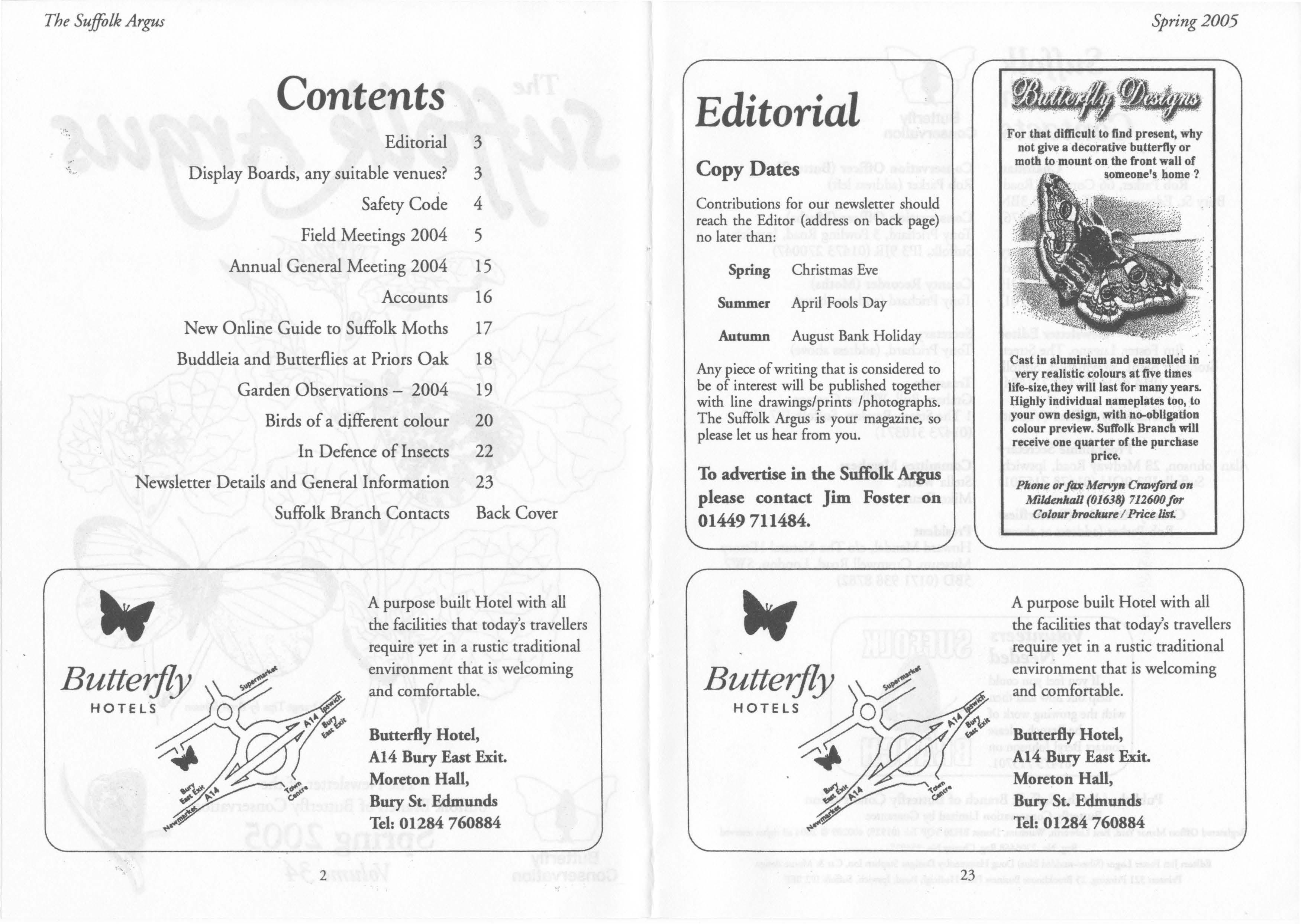
please contact Jim Foster on
01449 711484.
•wt . 4 ·fldm rN .. . fir'"'
For that difficult to find present, why not give a decorative butterfly or moth to mount on the front wall of someone's home ?
Cast In aluminium and enamelled in very realistic colours at five times lif&-size, they will last for many years. Highly individual nameplates too, to your own desi!PI, with n~obllaatlon colour preview. Suffolk Branch will receive one quarter of the purchase price.
Phone or far Mervyn Crawford on MikJen/raJJ (01638) 712600for Colour brockure I Price list.
A purpose built Hotel with all the facilities that today's travellers require yet in a rustic traditional environment that is welcoming and comfortable.
Butterfly Hotel, Al 4 Bury East Exit. Moreton Hall, Bury St. Edmunds
Tel: 01284 760884
Suffolk Branch Contacts Butterfly Conservation
Chairman
Rob Parker, 66 Cornfield Road, Bury St. Edmunds, Suffolk IP33 3BN (01284 705476)
Membership Secretary
Newsletter Editor
Jim Foster, Lugano, The Street, Stonham Aspal, Stowmarket, Suffolk IP14 6AH (01449 711484)
Publicity Officer (Vacant)
Programme Secretary
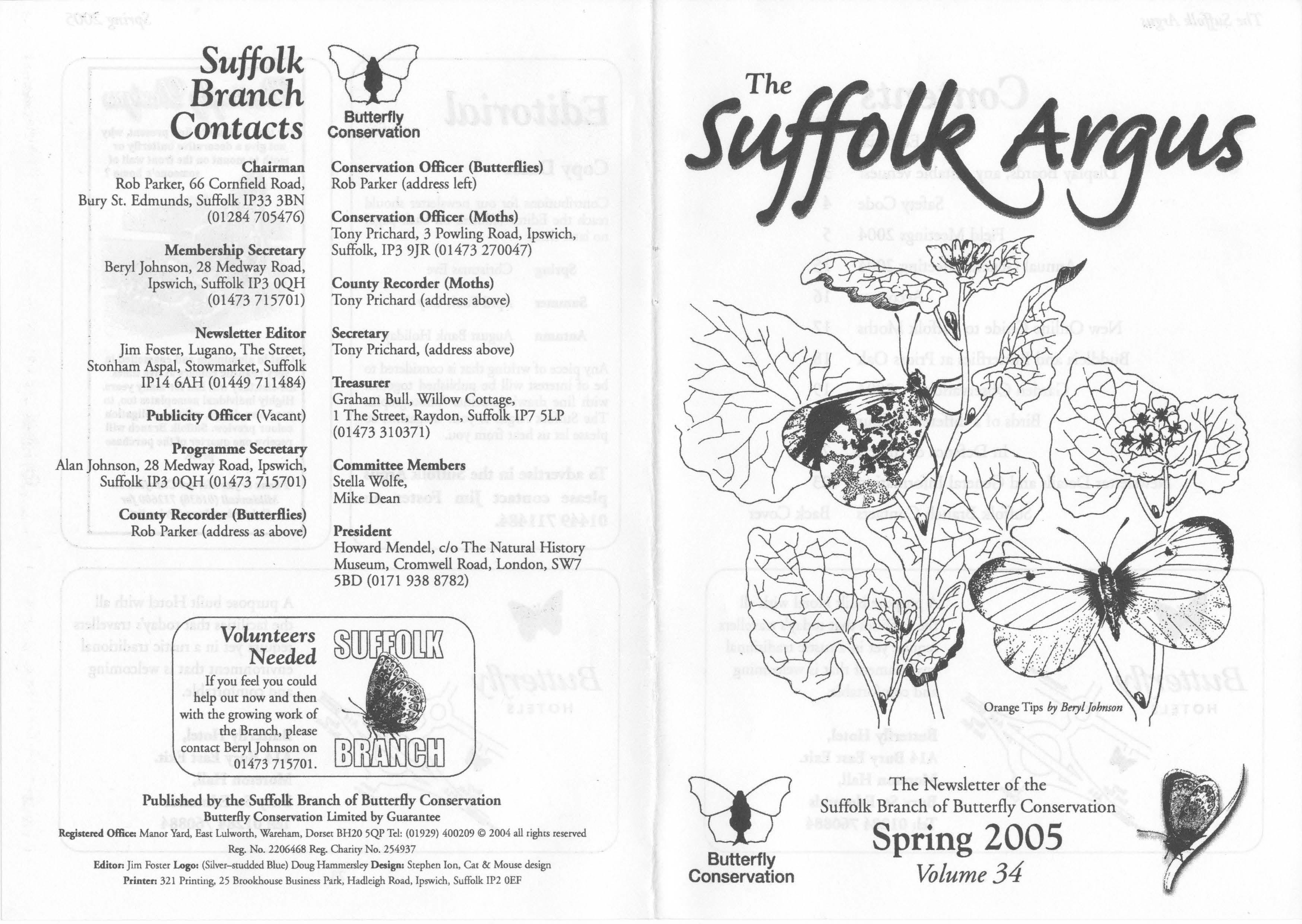
County Recorder (Butterflies) Rob Parker (address as above)
Conservation Officer (Butterflies)
Rob Parker (addr<:5s left)
Conservation Officer (Moths)
Tony Prichard, 3 Powling Road, Ipswich, Suffolk, IP3 9JR (01473 270047)
County Recorder (Moths)
Tony Prichard (address above)
Secretary
Tony Prichard, (address above)
Treasurer
Graham Bull, Willow Cottage, 1 The Street, Raydon, Suffolk IP? 5LP (01473 310371)
Committee Members
Stella Wolfe, Mike Dean
President
Howard Mendel, c/o The Natural History Museum, Cromwell Road, London, SW? 5BD (0171 938 8782)
Volunteers Needed
If you feel you could help out now and then with the growing work of the Branch, please contact Beryl Johnson on 01473 715701.
Published by the Suffolk Branch of Butterfly Conservation
Butterfly Conservation limited by Guarantee
R,gistcrcd Office: Manor Yard, East Lulworth, Wareham, Dorset BH20 5QP Td: (01929) 400209 © 2004 all rights reserved Reg. No. 2206468 Reg. Charity No. 254937 Editor: Jim Foster Logo: (Silver-scudded Blue) Doug Hammersley Design: Stephen Ion, Cat & Mouse design Printer. 321 Printing, 25 Brookhouse Business Park, Hadleigh Road, Ipswich, Suffolk IP2 0EF



